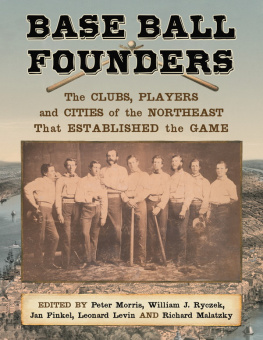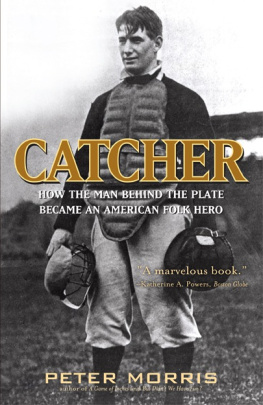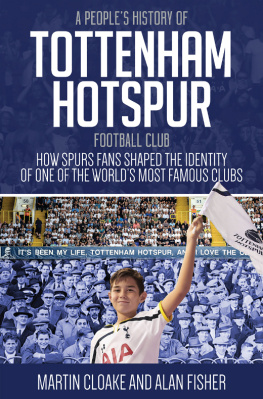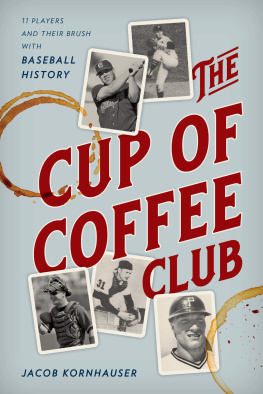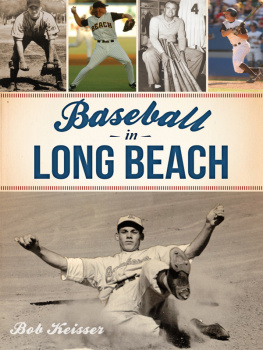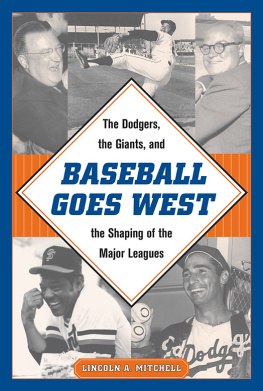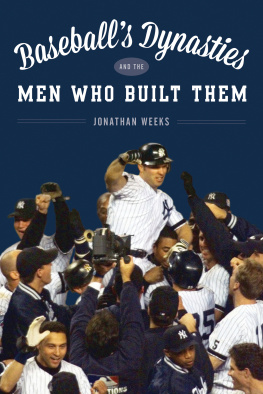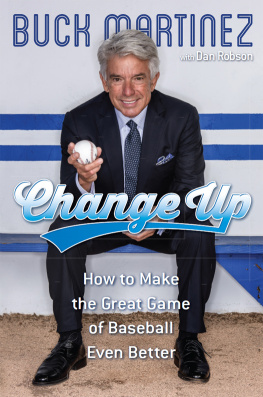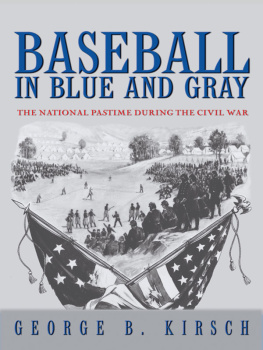
Base Ball Founders
The Clubs, Players and Cities of the Northeast That Established the Game
Edited by Peter Morris, William J. Ryczek, Jan Finkel, Leonard Levin and Richard Malatzky

McFarland & Company, Inc., Publishers
Jefferson, North Carolina, and London
LIBRARY OF CONGRESS CATALOGUING DATA ARE AVAILABLE
BRITISH LIBRARY CATALOGUING DATA ARE AVAILABLE
e-ISBN: 978-1-4766-0378-0
2013 Peter Morris, William J. Ryczek, Jan Finkel, Leonard Levin and Richard Malatzky. All rights reserved
No part of this book may be reproduced or transmitted in any form or by any means, electronic or mechanical, including photocopying or recording, or by any information storage and retrieval system, without permission in writing from the publisher.
On the cover: The Excelsiors of Brooklyn, 1860 (A. G. Spalding Baseball Collection, New York Public Library); (background) lithograph of New York City by Charles Parsons, 1856
McFarland & Company, Inc., Publishers
Box 611, Jefferson, North Carolina 28640
www.mcfarlandpub.com
To the memory of
Fred Ivor-Campbell, Bob McConnell and David Ball,
three stellar baseball historians who didnt live
to see the completion of this project.
Introduction
William J. Ryczek
In April 2012, Base Ball Pioneers, 18501870, chronicling the spread of baseball beyond the areas of its birth, appeared in print from McFarland. It included an eloquent introduction by Peter Morris that described the origin of the concept of the Pioneer Project, the basic outline of that volume and this one, and the various contributions that brought both to fruition.
Peter Morris specializes in people, almost exclusively dead people. The former director of our local historical society had a sign posted on her ofce door that read, If youre not dead, were not interested. So it is with Peter. His indefatigable thirst for genealogical data provided the backbone for most of the player proles contained in both volumes, and his delight in nding the missing and the intriguing added immeasurably to the value of the work. In contradiction of the common adage, Morriss dead people told many tales. Some, like William Wheaton, were meaningful contributors to the development of the game; some, like Alexander Cartwright, led very interesting lives after their baseball days were over; and others, like Joseph Vanderbilt, catcher of the Eckford Base Ball Club of Brooklyn and grandfather of advice columnist Amy Vanderbilt, spawned prominent descendants.
As they did for the rst volume, Jan Finkel and Len Levin copy edited the entire manuscript and their tactful craftsmanship again produced proper grammar, style and usage in the text and intact self-esteem on the part of the contributors. Roger Erickson and Skip McAfee likewise volunteered their expertise in indexing.
In addition to Peter, Jan and Len, the material for this work is the product of many authors, all authorities on the clubs they covered and all working on a voluntary basis, fueled by intellectual curiosity, a desire to share with the reading public what they have learned about early baseball, and the relentless prodding of the editorial team.
The clubs proled in Base Ball Founders are those that played in the areas of the United States in which baseball originated: New York, Boston, Philadelphia and the surrounding regions. Those three cities were the most populous in the United States during the time of baseballs birth, and it is natural that the game would have been begun there. It did not arise in similar form in all three cities, however. During the 1850s, for the most part, the game played in Boston was the Massachusetts Game, which yielded to the New York version in popularity after the Civil War. Early ball games in Philadelphia were the old game of town ball, which also gave way to the New York game.
Every year, new information regarding baseballs earliest days is discovered, some of which is in conict with what we thought we knew, some of which conrms and expands upon our existing knowledge, and some of which raises even more questions that we hope can be answered by further research. John Thorn discovered the virtually unknown Magnolia Base Ball Club of the 1840s, and his chapter on the New York Base Ball Club (also known as the Washington and Gotham base ball club) contains much new information about the early days of the organization, a period coincident with the birth of New York baseball.
Some club histories, notably those of the Atlantics and the New York clubs, are much longer than others. Baseball began in New York, and soon spread to Brooklyn; therefore, clubs in those cities had a longer history than those that adopted the game later. More signicantly, those clubs, and the Knickerbockers, had a major inuence on the development of the game, and their members were among the most prominent gures in early baseball. The New York and Knickerbocker clubs were instrumental in the formalization of the game and the transformation of the sport from an informal recreational activity to a structured business venture. The Atlantics, although they were formed much later than the former two organizations, were the dominant nine on the playing eld from the late 1850s through 1870. We hope the reader will indulge us the relatively large amount of space devoted to these leading pioneers.
We hope this book will be a page turner not in the sense of a dramatic mystery novel, in which one races through the text to see the mystery unraveled, but in a way that will make you ip both forward and back to see the inter-relationships of the clubs and players. Early baseball clubs were often uid, and the names of William Wheaton, Doc Adams, and others appear in the histories of more than one pioneer club. We have treated the two volumes as complementary, to be read as one; therefore, if a player is proled in Base Ball Pioneers, 18501870, we have referred the reader to it rather than repeat the information here.
When looking back on a project after it is nished, one must determine whether it has achieved its planned objectives. As Peter stated in his introduction to the rst volume, our primary purpose in producing this work, which took several years to nalize, was to set forth the heretofore untold story of the clubs and players who played the game prior to 1870. An ancillary purpose was to provide a comprehensive reference source for those who want to learn more about baseballs earliest days, and who may undertake further research and build upon the data weve presented. The standard contemporary source on the history of early baseball was The Book of American Pastimes, published in 1866 by Charles A. Peverelly. A century and a half after its appearance, Peverellys work still serves as a valuable research tool, but we now know much more than Peverelly knew in 1866, and there is much additional information presented in these pages. The nal judgment as to whether we have achieved our goals rests, of course, with our readers, and we hope you will nd both volumes interesting and useful.
Timeline of the Pioneer Era
Robert Tholkes
Base Ball Founders, like its companion volume, Base Ball Pioneers, focuses on what we have referred to as the pioneer era. Beginning with the earliest inter-club matches and ending with the advent of professional baseball, the period includes all of the 1850s and 1860s. Viewed with 150 years hindsight, the events of the period unspool in a logical sequence of inevitable steps.
Next page
